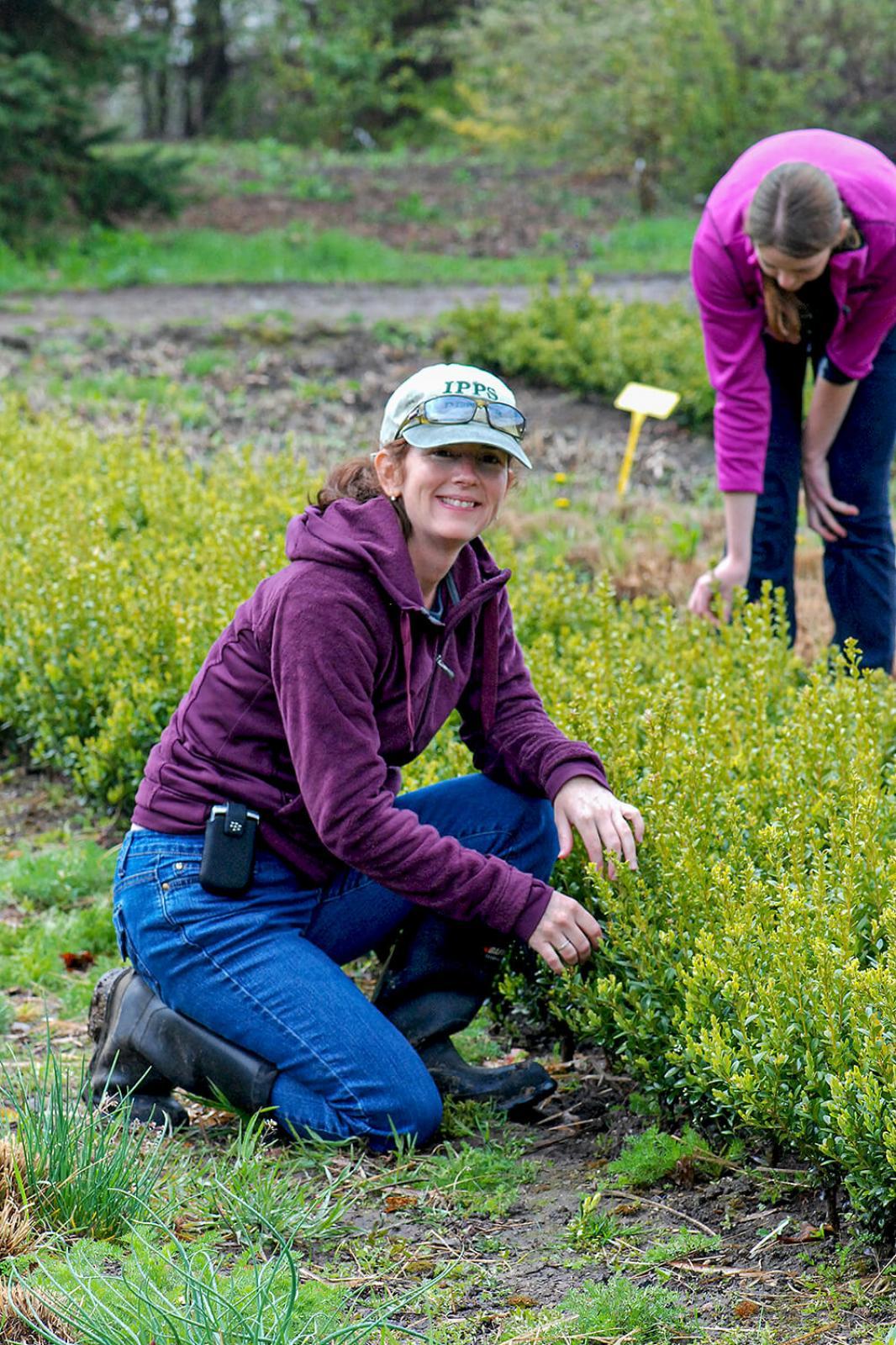January 15, 2013
OMAFRA, university and LO provide nursery scout

Jen Llewellyn supervised the nursery scout project and worked closely with Danielle to provide support with monitoring, diagnostics and recommendations.
OMAFRA nursery crops specialist
In 2012, we were fortunate to receive funding through Landscape Ontario to hire a nursery scout to monitor services in Ontario.
This was the second consecutive year that OMAFRA, University of Guelph and Landscape Ontario partnered to provide a dedicated nursery scout for the industry. Danielle Fife, a graduate of Environmental Biology (entomology) from the University of Guelph, was hired for the field season and was quickly up to speed on plant identification and common pests and diseases on outdoor ornamentals.
The primary objective of the nursery scout is to support integrated pest management (IPM) programs in the nursery industry by providing monitoring services and training with growers and nursery staff. At the same time, it was a chance to further develop a relationship among all those involved, so that information and ideas could be more easily exchanged.
As you can imagine, Danielle learned just as much from the nursery growers as they learned from her. I supervised and trained Danielle, and we worked closely together to troubleshoot plant quality and pest issues.
The University of Guelph’s Insect Systematics Lab (Dr. Steve Marshall) provided timely assistance with insect diagnostics, while the Pest Diagnostic Clinic (Dr. Xuechan Shan) provided disease identification.
 Danielle Fife was well known at several nurseries this past year for her exceptional skills in monitoring and pest identification.
Danielle Fife was well known at several nurseries this past year for her exceptional skills in monitoring and pest identification.
Having a dedicated nursery scout to carry out regular monitoring has the potential to:
- Provide more accurate identification of pests and diseases and beneficial insects
- Provide more crop-specific information on behaviour and host preference of pests
- Detect pests earlier, thereby managing pests at a lower population level and hopefully reducing severity of injury (and number of pesticide applications)
- Evaluate efficacy of current management strategies employed at the operation
- Network with crop specialists and researchers to increase the IPM toolkit for the operation
Most nurseries sent a staff member with Danielle as part of informal training. Some nurseries would send a different staff member each week, so that more staff could become familiar with monitoring. For those nurseries, this increased the skill set and number of staff looking out for potential problems. Participating nursery staff members were all very knowledgeable. Danielle found this a great learning opportunity, enabling her to share an even greater amount of information with other participating nurseries.
The nursery scout notified growers of all immediate concerns and each week provided a customized, photographic report (including lab diagnostic reports) to each grower. Growers really appreciated the extra set of eyes and would often compare Danielle’s reports to their own to determine what they might have missed. The monitoring data from these reports was incorporated into my weekly newsletter, the OMAFRA Nursery-Landscape Report. In this sense, the nursery scout’s data was available to benefit IPM programs in nursery production and landscape maintenance across the province. I often sent Danielle’s photos (Power Point slideshows) out with my weekly email report.
Weather influence
This season we saw a great deal of physiological stress in nursery stock due to the sporadic, extreme weather conditions in early spring and summer. The early, warm spell in March led to very early bud break. This left a lot of tender foliage at the mercy of all those low temperature events in May. Danielle was rated very highly for her scouting services by participating growers.
Danielle was rated very highly for her scouting services by participating growers.
Growers found that most crops (and pests) were about three weeks ahead of normal development for that time of year. The summer was exceptionally hot and dry. As a result, we saw a lot of symptoms related to desiccation and heat stress, such as scorch, burnt leaves, wilting and leaf drop. This was evident on deciduous, as well as several evergreens (such as Pinus and Picea) in the nursery, and in several landscapes.
Although the dry weather provided poor conditions for most diseases, powdery mildew still ran rampant across several deciduous species (Amelanchier sp.). The hot weather provided excellent conditions for mites, aphids and leafhoppers to build populations and cause much economic injury on outdoor ornamentals.
Danielle reports that this was a very positive experience for her. She gained a greater sense of independence, horticultural field experience, self-directed study and improved communication skills. Danielle said that she felt the industry appreciated her for her work. That is something with which I can really identify from my years of working with all of you.
Danielle has gone off to Acadia University to pursue a Master’s degree in biology and unfortunately will not return as the nursery scout. All of the growers are hoping that the nursery scout service will be available in 2013. In the past two years, Landscape Ontario has received funding to support this project (Farm Innovation Program, Agricultural Adaptation Council).
We are working closely with Landscape Ontario to evaluate potential funding sources for this coming growing season. Your feedback and ideas are always appreciated. My dream is to one day supervise a team of seasonal staff to scout Ontario nurseries and landscapes to help further improve IPM programs for our green industry.
Jennifer Llewellyn may be contacted at the Bovey Building, University of Guelph, at 519-824-4120, ext. 52671, or jennifer.llewellyn@ontario.ca.